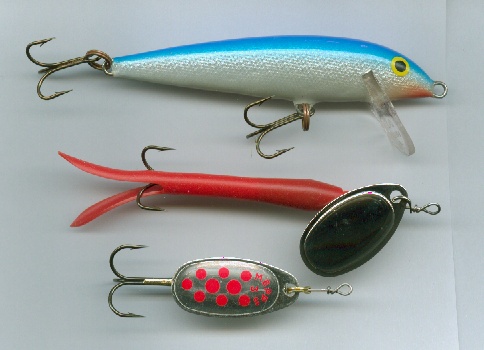 Adjacent
is a selection of spinners used on the Taf for salmon and seatrout: Rapala,
Flying C and Mepps.
Adjacent
is a selection of spinners used on the Taf for salmon and seatrout: Rapala,
Flying C and Mepps.|
TACTICS
|
The Taf is a small spate river which has an interesting mixture of deep pools, riffles and runs. There are numerous areas of clear bank which allow easy casting but there are also areas of bank lined with trees and bushes which provide more challenging fishing. Traditionally the river fished best three days after heavy rain but following the implementation of flood prevention schemes in the Whitland area in recent years, water levels now drop much more quickly and the river is best fished the day after rain.
When there is a good flow of water in the river, fishing with a "bunch" of worms (usually 2/3 brandlings or lobworms) is an effective method of catching salmon or seatrout. The weights used should be light enough to allow the worms to trundle along the river bed. Most anglers use lines of between 10 to 15lb breaking strain. In lower water conditions seatrout can be taken from runs by fishing a single worm on lighter lines of 6-8lb.
If the water is very coloured a Yellow Flying C 15g or a 9 or 7 Gold Fluorescent Red Rapala or Red Clown Rapala is recommended for salmon and seatrout. When the water colour is less intense a Red Flying C or a Blue Rapala should prove more successful. In clearer water the Rainbow Rapala or Brown Trout Rapala is more effective. Many local anglers use the Mepps Aglia Comet Silver with Red Spots or Silver with Blue Spots when spinning for seatrout. Lines of between 10 to 15lb are usually employed.
 Adjacent
is a selection of spinners used on the Taf for salmon and seatrout: Rapala,
Flying C and Mepps.
Adjacent
is a selection of spinners used on the Taf for salmon and seatrout: Rapala,
Flying C and Mepps.
The majority of anglers find that intermediate lines suit their general needs best when flyfishing for seatrout and salmon. Floating lines are used in low water conditions, while sinking lines tend only to be used in April or early May to search out deeper pools. Most situations can be catered for with leader lengths of 3-6ft. It is recommended that a breaking strain of at least 6lb be used because of the possibility of hooking large fish and the need to steer smaller fish away from tree roots; many local anglers use leaders of 8-10lb.
Size 8 is the normal hook size used for evening fishing for seatrout with smaller sizes being used for clear water daytime visits. Sweeny Todd, Peter Ross and Butcher are popular evening patterns but seatrout are occasionally taken in the daytime from fast runs on size 14 Dunkeld or Mallard and Claret by anglers fishing for trout. March Brown, Silver March Brown and Greenwell's Glory are popular early season flies for trout, while the seatrout flies mentioned above will, in sizes 10 to 14 also take trout. The majority of Taf salmon are caught on worm or spinner but some success has been achieved with Silver Stoat and Dovey Black and Orange.
The patterns which have proved consistently successful on the Taf for evening flyfishing for seatrout are as follows:
 Hook:
long shank 8/10. Body: black floss. Rib: silver oval tinsel. Thorax: magenta
floss. Hackle: magenta/red hen. Wing: black squirrel
Hook:
long shank 8/10. Body: black floss. Rib: silver oval tinsel. Thorax: magenta
floss. Hackle: magenta/red hen. Wing: black squirrel
 Hook:
standard 8/10. Tail: golden pheasant tippets. Body: front half red seal fur
substitute; rear half flat silver tinsel. Rib: oval silver tinsel. Hackle: black
hen. Wing: teal flank feather.
Hook:
standard 8/10. Tail: golden pheasant tippets. Body: front half red seal fur
substitute; rear half flat silver tinsel. Rib: oval silver tinsel. Hackle: black
hen. Wing: teal flank feather.
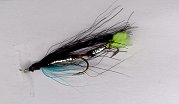 Hook:
longshank10 and treble 14. Tag: fluorescent green wool. Body: flat silver tinsel.
Rib: silver wire. Hackle: blue hen. Wing: black bucktail.
Hook:
longshank10 and treble 14. Tag: fluorescent green wool. Body: flat silver tinsel.
Rib: silver wire. Hackle: blue hen. Wing: black bucktail.
 Hook:
standard 8/10. Tail: red ibis substitute. Body: flat silver tinsel. Rib: silver
wire. Hackle:black hen. Wing: blue section from mallard wing.
Hook:
standard 8/10. Tail: red ibis substitute. Body: flat silver tinsel. Rib: silver
wire. Hackle:black hen. Wing: blue section from mallard wing.
 Hook:
standard 8-14. Tail: golden pheasant topping. Body: flat gold tinsel. Rib: gold
wire. Hackle:hot orange cock. Wing: bronze mallard. Cheeks (optional): jungle
cock eyes.
Hook:
standard 8-14. Tail: golden pheasant topping. Body: flat gold tinsel. Rib: gold
wire. Hackle:hot orange cock. Wing: bronze mallard. Cheeks (optional): jungle
cock eyes.
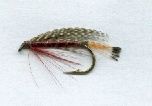 Hook:
standard 8-14. Tail: golden pheasant tippets. Body: claret seal's fur substitute.
Rib: gold wire. Hackle: ginger or claret hen. Wing: bronze mallard.
Hook:
standard 8-14. Tail: golden pheasant tippets. Body: claret seal's fur substitute.
Rib: gold wire. Hackle: ginger or claret hen. Wing: bronze mallard.
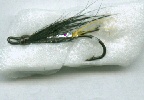 Hook:
single or double 6-8. Tail: golden pheasant topping. Body: flat silver tinsel.
Rib: silver wire. Hackle: black hen. Wing: black tip of stoat's tail or black
bucktail.
Hook:
single or double 6-8. Tail: golden pheasant topping. Body: flat silver tinsel.
Rib: silver wire. Hackle: black hen. Wing: black tip of stoat's tail or black
bucktail.
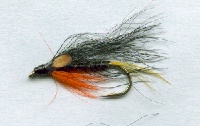 Hook:
single or double 6-8. Tail: yellow swan. Body: black floss. Rib: silver wire.
Hackle: orange hen. Wing: black squirrel. Cheeks: jungle cock eyes.
Hook:
single or double 6-8. Tail: yellow swan. Body: black floss. Rib: silver wire.
Hackle: orange hen. Wing: black squirrel. Cheeks: jungle cock eyes.